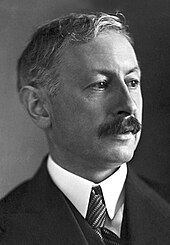Paul Karrer
Paul Karrer (born April 21, 1889 in Moscow , † June 18, 1971 in Zurich ) was a Swiss chemist and Nobel Prize winner for chemistry (1937).
Life
The son of a dentist grew up in Switzerland, studied chemistry at the University of Zurich and was at 1911 Alfred Werner with the work of the cobalt valence isomerization studies of doctorate . From 1912 to 1918 he worked on the synthesis of organic arsenic compounds in the laboratory of the physician Paul Ehrlich in Frankfurt am Main and returned to the University of Zurich in 1918 as an associate professor of organic chemistry. From 1919 until his retirement in 1956 he was Alfred Werner's successor as director of the Institute of Chemistry. In 1950/51 he was also rectorthe University. In Zurich, Karrer researched polysaccharides , which have been plant pigments since 1926. He isolated vitamins A (1931) and K (1939) and synthesized vitamins B 2 and E, among others . He also examined the constitution of the carotenoids and flavins . His “Textbook of Organic Chemistry” , published in 1927, has been published and translated many times. His fields of work later also included the investigation of therapeutically active substances, including above all curare alkaloids, which are used for anesthesiology . Karrer was a member of numerous scientific academies, such as the German Academy of Sciences Leopoldina since 1925 , the Royal Society of Edinburgh since 1943 , the National Academy of Sciences since 1945 and the Royal Society and the Académie des Sciences since 1947, as well as chemical and biochemical societies. He died in 1971 at the age of 82 and was buried in the Fluntern cemetery in Zurich .
He was a member of the Swiss student union Argovia Aarau .
His brother Walter Karrer (1891–1961) was also a chemist.
Services
- stereochemical studies on amino acids .
- 1931 Structure elucidation of vitamin A ( retinol ).
- Structure elucidation and synthesis of squalene , the first synthesis of a naturally occurring triterpene
- 1932 Structure elucidation and synthesis of vitamin B 2 ( riboflavin )
- 1938 Structure elucidation and synthesis of vitamin E ( tocopherol )
- 1939 pure representation of vitamin K 1 ( phylloquinone )
Awards
Paul Karrer received the Marcel Benoist Prize in 1922 and the Canizzaro Prize in 1935. In 1925 he was accepted into the German Academy of Natural Scientists Leopoldina . 1937 Karrer was awarded for his research on the structure of carotenoids, the flavins and vitamins A and B together with Norman Haworth the Nobel Prize in Chemistry .
The University of Zurich's Paul Karrer Lecture and Medal has been awarded to outstanding chemists since 1959. The moon crater Karrer is named after him.
Fonts
- Paul Karrer, Ernst Jucker: Carotenoids . Birkhäuser Basel, Basel 1948, ISBN 978-3-0348-6789-4 , doi : 10.1007 / 978-3-0348-6802-0 ( springer.com - English edition Carotenoids 1950 online ).
- Textbook of organic chemistry , first edition, Stuttgart, 1927, 14th edition Stuttgart: Thieme 1963
literature
- Hans-Jürgen Hansen: Karrer, Paul. In: Historical Lexicon of Switzerland .
- Gerhard Hesse: Karrer, Paul. In: New German Biography (NDB). Volume 11, Duncker & Humblot, Berlin 1977, ISBN 3-428-00192-3 , pp. 297-299 ( digitized version ).
- Literature by and about Paul Karrer in the catalog of the German National Library
Web links
- Search for "Paul Karrer" in the German Digital Library
-
Search for "Paul Karrer" in the online catalog of the Berlin State Library - Prussian Cultural Heritage . Attention : The database has changed; please check result and
SBB=1set - Information from the Nobel Foundation on the award ceremony for Paul Karrer in 1937 (English) and a banquet speech (German)
Individual evidence
- ↑ a b c Curriculum Vitae Prof. Dr. Paul Karrer. In: Members> Members with Nobel Prize. German Academy of Sciences Leopoldina, accessed on May 16, 2019 .
- ↑ biographical data, publications and Academic pedigree of Paul Karrer in academictree.org, accessed on February 15 2018th
- ^ Fellows Directory. Biographical Index: Former RSE Fellows 1783–2002. (PDF file) Royal Society of Edinburgh, accessed December 25, 2019 .
- ^ Member Directory: Paul Karrer. National Academy of Sciences, accessed February 24, 2017 .
- ^ Entry on Karrer, Paul (1889-1971) in the archives of the Royal Society , London
- ^ List of members since 1666: Letter K. Académie des sciences, accessed on January 6, 2020 (French).
- ↑ Klaus Nerger: The grave of Paul Karrer. In: knerger.de. Retrieved June 18, 2021 .
- ^ "Acta Studentica", episode. 134, March. 2001, p. 6
- ↑ Paul Karrer, A. Helfenstein: Synthesis of Squalens . In: Helvetica Chimica Acta . tape 14 , no. 1 , 1931, ISSN 0018-019X , p. 78-85 , doi : 10.1002 / hlca.19310140107 ( wiley.com ).
| personal data | |
|---|---|
| SURNAME | Karrer, Paul |
| BRIEF DESCRIPTION | Swiss chemist and Nobel Prize winner for chemistry |
| DATE OF BIRTH | April 21, 1889 |
| PLACE OF BIRTH | Moscow |
| DATE OF DEATH | June 18, 1971 |
| PLACE OF DEATH | Zurich |
